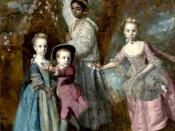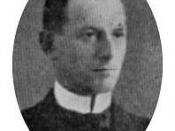"The Catcher in the Rye" describes the path to adulthood, and its failure, in an adolescent male. Holden Caulfield, the main character, introduces himself very abruptly, immediately demonstrating to the reader his depressed, emotional position. Holden, then describes how he is the only person not attending the football game, showing the extent that he isolates himself from society. When Holden gets to Mr. Spencer's house the reader can see that Mr. Spencer tries to help Holden do well in school, but Holden refuses to accept his help, labeling Mr. Spencer as a "phony".
The most revealing scene about Holden's character is when he describes to Phoebe that he want to be a "catcher in the rye" where children are playing in a field of rye which overlooks a cliff, and when they start to go over the cliff, he must catch them. The field of rye represents childhood and a child's innocence.
Holden views adulthood as falling over a cliff, he actively denotes almost every adult as being "phony". And thus Holden is protecting the children's innocence. He demonstrates this by attempting to rub off the graffiti in the school, but he realizes that he could never rub off even half of all the obscenities in the world, and he is afraid that some kid will explain it to the children and that this will corrupt their innocence. However Mr. Antolini tries to help Holden avoid a "fall" that he is headed towards. In a way Mr. Antolini is the catcher in the rye, however he tries to protect Holden from a "fall" that comes from not being able to mature, as opposed to a fall that comes as a result of maturity. This contradicts Holden's philosophy and shows the reader Holden's perspective on life is distorted.
Throughout the book, Holden faces the problem that he never wants to mature. He under goes constant mood swings and convinces himself that his insane schemes will work. He cannot deal with change, which is why he is troubled that his deceased younger brother Allie would just disappear into death. It is this reason why he constantly asks about the ducks in Central Park because he doesn't want to believe that an object can just disappear and be gone. Holden's fear of change is seen in his love of the museum. Everything in the museum stays the same every time he goes.
Throughout the book Holden has problems communicating with people. He tend to follow a pattern of loneliness, calling a friend, mental criticism about the friend, anxiousness to see the friend, brief happiness, followed by some form of rudeness, and then sorrow for his stupidity. His failure to communicate with people only leads to his isolation in an endless cycle. The beauty of the museum to Holden is that communication is one way. Holden can judge the Indian mannequins, but they cannot judge or isolate him. This is a thrilling book; it perfectly articulates feelings of adolescent isolation, and the events leading up to Holden's emotional breakdown.



Question
Does Holden always live up to his criticisms of the adult world, or do his criticisms contain hypocrisy?
3 out of 3 people found this comment useful.